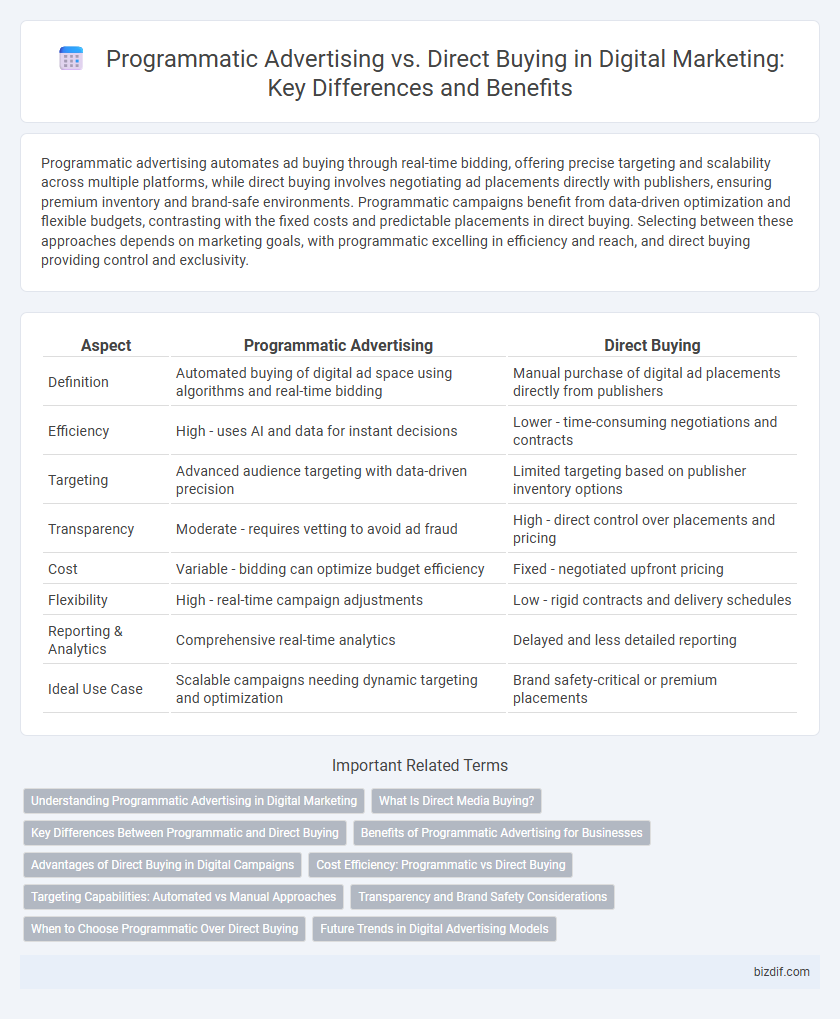Programmatic advertising automates ad buying through real-time bidding, offering precise targeting and scalability across multiple platforms, while direct buying involves negotiating ad placements directly with publishers, ensuring premium inventory and brand-safe environments. Programmatic campaigns benefit from data-driven optimization and flexible budgets, contrasting with the fixed costs and predictable placements in direct buying. Selecting between these approaches depends on marketing goals, with programmatic excelling in efficiency and reach, and direct buying providing control and exclusivity.
Table of Comparison
| Aspect | Programmatic Advertising | Direct Buying |
|---|---|---|
| Definition | Automated buying of digital ad space using algorithms and real-time bidding | Manual purchase of digital ad placements directly from publishers |
| Efficiency | High - uses AI and data for instant decisions | Lower - time-consuming negotiations and contracts |
| Targeting | Advanced audience targeting with data-driven precision | Limited targeting based on publisher inventory options |
| Transparency | Moderate - requires vetting to avoid ad fraud | High - direct control over placements and pricing |
| Cost | Variable - bidding can optimize budget efficiency | Fixed - negotiated upfront pricing |
| Flexibility | High - real-time campaign adjustments | Low - rigid contracts and delivery schedules |
| Reporting & Analytics | Comprehensive real-time analytics | Delayed and less detailed reporting |
| Ideal Use Case | Scalable campaigns needing dynamic targeting and optimization | Brand safety-critical or premium placements |
Understanding Programmatic Advertising in Digital Marketing
Programmatic advertising leverages automated technology and real-time bidding to target specific audiences efficiently across multiple digital channels, optimizing ad spend and campaign performance. Direct buying involves purchasing ad space directly from publishers, offering more control over inventory but often lacks the scalability and data-driven precision of programmatic methods. Understanding programmatic advertising is crucial for maximizing reach and improving return on investment in digital marketing campaigns.
What Is Direct Media Buying?
Direct media buying involves purchasing advertising space directly from publishers or media owners without intermediaries, allowing for greater control over ad placements, creative content, and negotiation of pricing. This method ensures brand safety, precise audience targeting, and often results in better transparency and stronger relationships with media sellers. In contrast to programmatic advertising, direct buying bypasses automated bidding systems, relying instead on manual agreements and predefined terms.
Key Differences Between Programmatic and Direct Buying
Programmatic advertising automates the buying process using algorithms and real-time bidding, enabling advertisers to target specific audiences efficiently, whereas direct buying involves negotiating and purchasing ad space directly from publishers, offering more control over placement and premium inventory. Programmatic provides scalability and data-driven optimization, while direct buying ensures brand safety and fixed pricing. These distinctions impact campaign strategy, budget allocation, and overall advertising effectiveness in digital marketing.
Benefits of Programmatic Advertising for Businesses
Programmatic advertising leverages automated technology and real-time data to optimize ad placements, resulting in higher targeting precision and cost efficiency compared to direct buying. Businesses benefit from enhanced audience segmentation, dynamic campaign adjustments, and improved return on investment through data-driven decisions. Access to a vast ecosystem of ad inventory and advanced analytics tools further empowers marketers to scale campaigns effectively and quickly adapt to market trends.
Advantages of Direct Buying in Digital Campaigns
Direct buying in digital campaigns ensures premium inventory access and precise audience targeting by collaborating directly with publishers. It enhances transparency and control over ad placements, minimizing fraud risks and optimizing campaign performance. This approach fosters stronger brand safety and tailored messaging, driving higher engagement and return on investment.
Cost Efficiency: Programmatic vs Direct Buying
Programmatic advertising leverages automated bidding and real-time data to optimize ad spend, often resulting in higher cost efficiency compared to direct buying. Direct buying involves fixed rates and upfront commitments, which can lead to less flexible budget allocation and potential overspending. Brands aiming to maximize ROI frequently prefer programmatic due to its dynamic pricing and precise audience targeting capabilities.
Targeting Capabilities: Automated vs Manual Approaches
Programmatic advertising leverages automated algorithms and real-time bidding to optimize targeting capabilities, allowing advertisers to reach specific audiences based on behavior, demographics, and contextual data with high precision. Direct buying relies on manual processes involving predefined audience segments and publisher negotiations, resulting in less dynamic but often more controlled placement. The automated approach in programmatic enhances scalability and adaptability, while manual targeting in direct buying offers more transparency and relationship-driven opportunities.
Transparency and Brand Safety Considerations
Programmatic advertising offers real-time bidding and precise audience targeting but often faces challenges with transparency due to the complex supply chain and potential ad fraud. Direct buying provides clearer control over placement and guaranteed brand safety by working directly with publishers, reducing risks of ad misplacement or fraud. Brands seeking transparency and robust safety measures prioritize direct buying to maintain trust and protect their reputation in digital marketing campaigns.
When to Choose Programmatic Over Direct Buying
Programmatic advertising is ideal for campaigns requiring real-time bidding and precise audience targeting, leveraging AI-driven algorithms to optimize ad placements across multiple platforms. Brands seeking scalability and efficiency benefit from programmatic's automated process, reducing the need for manual negotiations inherent in direct buying. This approach excels when targeting diverse demographics dynamically, while direct buying suits campaigns prioritizing premium inventory and guaranteed placements.
Future Trends in Digital Advertising Models
Programmatic advertising leverages AI-driven algorithms to automate ad buying, enabling real-time audience targeting and dynamic budget adjustments, representing the future trend toward efficiency and scalability in digital marketing. Direct buying remains relevant for premium placements and brand safety but is increasingly complemented by programmatic guaranteed deals that blend automation with assured inventory access. Emerging models emphasize data privacy compliance, cross-channel integration, and machine learning optimization to enhance campaign performance and measurement accuracy.
Programmatic advertising vs direct buying Infographic

 bizdif.com
bizdif.com